Air Washers
Air washers operate by first passing the air through fine sprays of water and then past baffle plates, on the wetted surface of which is deposited whatever dust and dirt were not caught by the sprays.
An air washer functions as a filter, humidifier, and dehumidifier. Using it to regulate the moisture in the air decreases its efficiency as a filter for removing airborne dust and dirt particles.
Air washers are classified as either two-unit or three-unit types. The two-unit air washer consists simply of sprays and eliminators as shown in Figure 12-29. A three-unit air washer includes a filter located between the sprays and eliminators (see Figure 12-30). Excluding the air filter, the basic components of a typical air washer are the following:
1. Cabinet
2. Spray nozzles
3. Eliminators or baffles
4. Sump
5. Pump
6. Blower
The major advantage of using an air washer instead of a conventional air filter or an electronic air cleaner is that it does not become clogged with dust and dirt and is therefore not subject to loss of
efficiency; however, air washers are no longer used in air-cleaning installations because of the following disadvantages:
1. Equipment bulk.
2. Higher operating expense.
3. Inefficiency in removing fine particles.
4. Tendency to add moisture to the air when the water is not cool.
